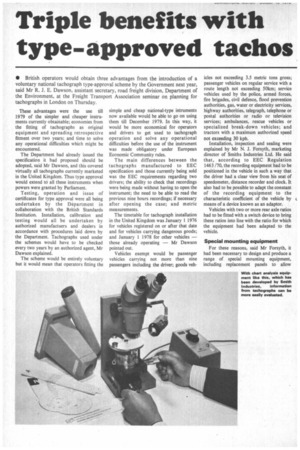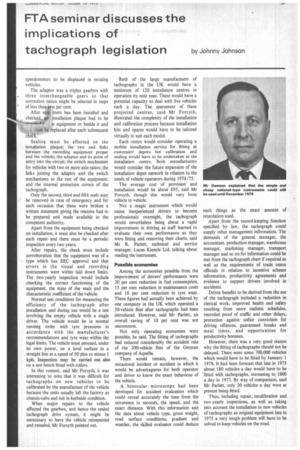Triple benefits with type-approved tachos
Page 40

Page 41

If you've noticed an error in this article please click here to report it so we can fix it.
• British operators would obtain three advantages from the introduction of a voluntary national tachograph type-approval scheme by the Government next year, said Mr R. J. E. Dawson, assistant secretary, road freight division, Department of the Environment, at the Freight Transport Association seminar on planning for tachographs in London on Thursday.
These advantages were the use till 1979 of the simpler and cheaper instruments currently obtainable; economies from the fitting of tachographs as original equipment and spreading retrospective fitment over two years; and time to solve any operational difficulties which might be encountered.
The Department had already issued the specification it had proposed should be adopted, said Mr Dawson, and this covered virtually all tachographs currently marketed in the United Kingdom. Thus type approval would extend to all these instruments when powers were granted by Parliament.
Testing, operation and issue of certificates for type approval were all being undertaken by the Department in collaboration with the British Standards Institution. Installation, calibration and testing would all be undertaken by authorized manufactuers and dealers in accordance with procedures laid down by the Department. Tachographs used under the schemes would have to be checked every two years by an authorized agent, Mr Dawson explained.
The scheme would be entirely voluntary but it would mean that operators fitting the simple and cheap national-type intruments now available would be able to go on using them till December 1979. In this way, it would be more economical for operators and drivers to get used to tachograph operation and solve any operational difficulties before the use of the instrument was made obligatory under European Economic Community rules.
The main differences between the tachographs manufactured to EEC specification and those currently being sold was the EEC requirements regarding two drivers; the ability to check that recordings were being made without having to open the instrument; the need to be able to read the previous nine hours recordings; if necessary after opening the case; and metric measurements.
The timetable for tachograph installation in the United Kingdom was January 1 1976 for vehicles registered on or after that date and for vehicles carrying dangerous goods; and January 1 1978 for other vehicles — those already operating — Mr Dawson pointed out.
Vehicles exempt would be passenger vehicles carrying not more than nine passengers including the driver; goods veh ides not exceeding 3.5 metric tons gross; passenger vehicles on regular service with a route length not exceeding 50km; service vehicles used by the police, armed forces, fire brigades, civil defence, flood prevention authorities, gas, water or electricity services, highway authorities, telegraph, telephone or postal authorities or radio or television services; ambulances, rescue vehicles or specialized break-down vehicles; and tractors with a maximum authorized speed not exceeding 30 kph.
Installation, inspection and sealing were explained by Mr N. J. Forsyth, marketing director of Smiths Industries Ltd. He said that, according to EEC Regulation 1463 /70, the recording equipment had to be positioned in the vehicle in such a way that the driver had a clear view from his seat of speedometer, distance recorder and clock. It also had to be possible to adapt the constant of the recording equipment to the characteristic coefficient of the vehicle by means of a device known as an adaptor.
Vehicles with two or more rear axle ratios had to be fitted with a switch device to bring these ratios into line with the ratio for which the equipment had been adapted to the vehicle.
Special mounting equipment For these reasons, said Mr Forsyth, it had been necessary to design and produce a range of special mounting equipment, including replacement panels to allow speedometers to be displaced in existing vehicles.
The adaptor was a triplex gearbox with three interchangeable gears so that correction ratios might be selected in steps of less than tro per cent.
After equ rnent has been installed and checked, an nstallation plaque had to be Le equipment or beside it and lost be replaced after each subsequent check.
Sealing must be effected on the installation plaque; the two end links between the recording equipment proper and the vehicle; the adaptor and its point of entry into the circuit; the switch mechanism for vehicles with two or more axle ratios; the links joining the adaptor and the switch mechanisms to the rest of the equipment; and the internal protection covers of the tachograph.
Only the second, third and fifth seals may be removed in case of emergency and for each occasion that these were broken a written statement giving the reasons had to be prepared and made available to the competent authority.
Apart from the equipment being checked on installation, it must also be checked after each repair and there must be a periodic inspection every two years.
After repairs, the check must include corroboration that the equipment was of a type which has EEC approval and that errors in the visual and recording instruments were within laid down limits. The two-yearly inspection would include checking the correct functioning of the equipment, the state of the seals and the characteristic coefficient of the vehicle.
Normal test conditions for measuring the efficiency of the tachograph after installation and during use would be a test involving the empty vehicle with a single driver. The vehicle would be in normal running order with tyre pressures in accordance with the manufacturer's recommendations and tyre wear within the legal limits. The vehicle must proceed, under its own power, on a level surface in a straight line at a speed of 50 plus or minus 5 kph. Inspection may be carried out also on a test bench fitted with rollers.
In this context, said Mr Forsyth, it was interesting to note that it was difficult for tachographs on new vehicles to be calibrated by the manufactuer of the vehicle because the units usually left the factory as chassis-cabs and not in kerbside condition.
When major repairs to the vehicle affected the gearbox, and hence the sealed tachograph drive system, it might be necesssary to have the vehicle reinspected and resealed, Mr Forsyth pointed out. Both of the large manufactuers of tachographs in the UK would have a minimum of 120 installation centres in operation by next year. These would have a potential capacity to deal with five vehicles each a day. The sparseness Of these projected centres, said Mr Forsyth, illustrated the complexity of the installation and calibration process because installation kits and spares would have to be tailored virtually to suit each model.
Each centre would consider operating a mobile installation service for fitting at customers' depots but calibration and sealing would have to be undertaken at the installation centre. Both manufacturers would consider the future expansion of the installation depot network in relation to the needs of vehicle operators during 1974/75.
The average cost of provision and installation would be about £95, said Mr Forsyth, though this would vary from vehicle to vehicle.
Not a magic instrument which would cause inexperienced drivers to become professionals overnight, the tachograph would nevertheless being about a rapid improvement in driving as staff learned to evaluate their own performance as they were fitting and removing their charts, said Mr R. Parlett, technical and service manager, Lucas Kienzle Ltd, talking about reading the instrument.
Possible economies Among the economies possible. from the improvement of drivers' performance were 20 per cent reduction in fuel consumption, 15 per cent reduction in maintenance costs and 10 per cent reduction in tyre wear. These figures had actually been achieved by one company in the UK which operated a 50-vehicle fleet after tachographs had been introduced. However, said Mr Parlett, an overall ' saving of 10 per cent was not uncommon.
Not only operating economies were possible, he said. The fitting of tachographs had reduced considerably the accident rate of the 200-vehicle fleet of the German company of Aquella.
There would remain, however, the occasional incident or accident in which it would be advantageous for both operator and driver to know the exact behaviour of the vehicle.
A binocular microscope had been developed for accident evaluation which could reveal accurately the time from the occurence in seconds, the speed, and the exact distance. With this information and the data about vehicle type, gross weight, road surface conditions, gradient and weather, the skilled evaluator could deduce such things as the exact amount of retardation used.
Apart from the record-keeping function specified by law, the tachograph could supply other management information. The demands of the general manager, the accountant, production manager, warehouse manager, marketing manager, transport manager and so on for information could be met from the tachograph chart if required as well as the requirements of trade union officials in relation to incentive scheme information, productivity agreements and evidence to support drivers involved in accidents.
Driver benefits to be derived from the use of the tachograph included a reduction in clerical work, improved health and safety resulting from more realistic schedules, recorded proof of traffic and other delays, protection against unfair conviction for driving offences, guaranteed breaks and meal times, and opportunities for productivity bonuses.
However, there was a very good reason why the fitting of tachographs should not be delayed. There were some 700,000 vehicles which would have to be fitted by January 1 1978. It had been forecast that late in 1975 about 180 vehicles a day would have to be ' fitted with tachographs, increasing to 1800 a day in 1977. By way of comparison, said Mr Parlett, only 20 vehicles a day were at present being fitted.
Thus, including repair, recalibration and two-yearly inspections, as well as taking into account the installation in new vehicles of tachographs as original equipment late in 1975 a very tough problem will have to be solved to keep vehicles on the road.








































































































